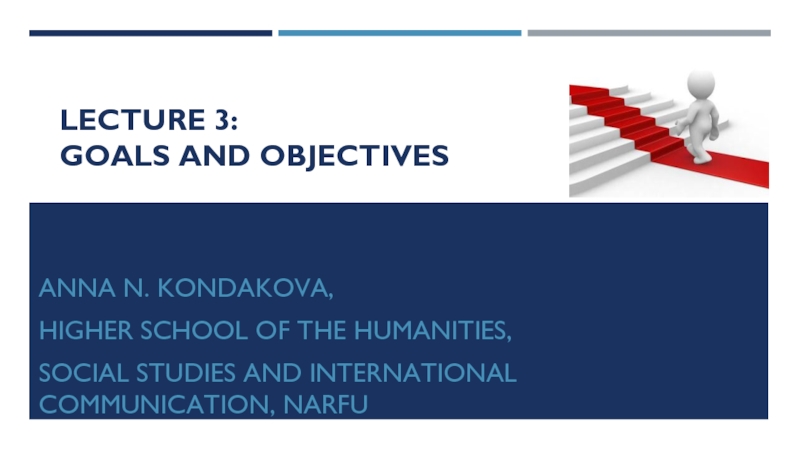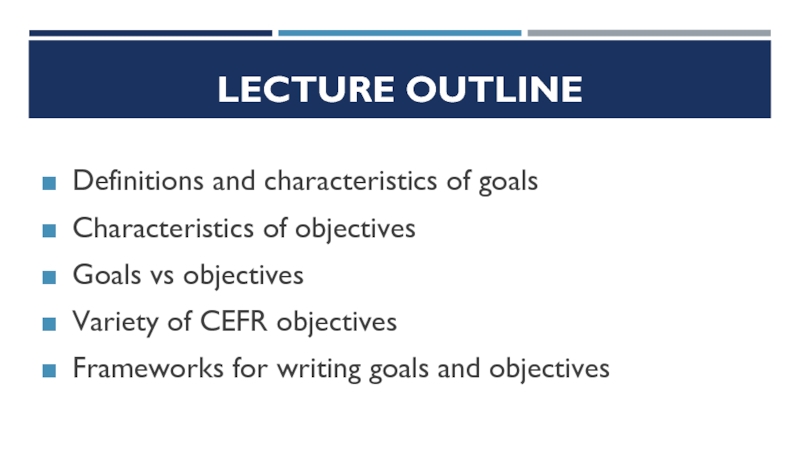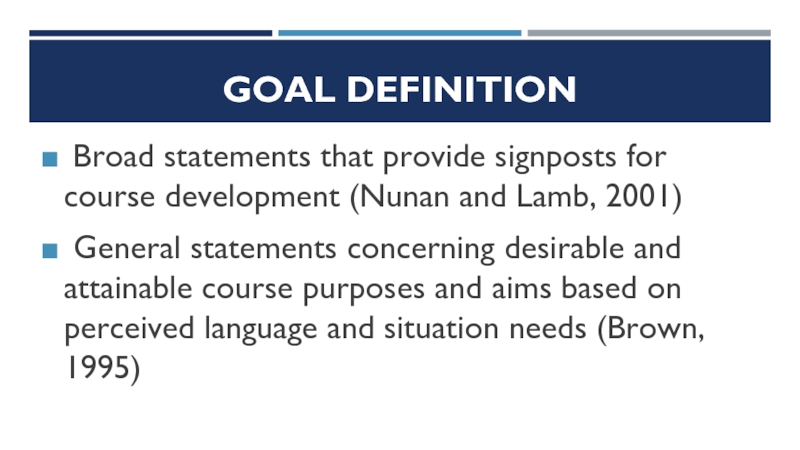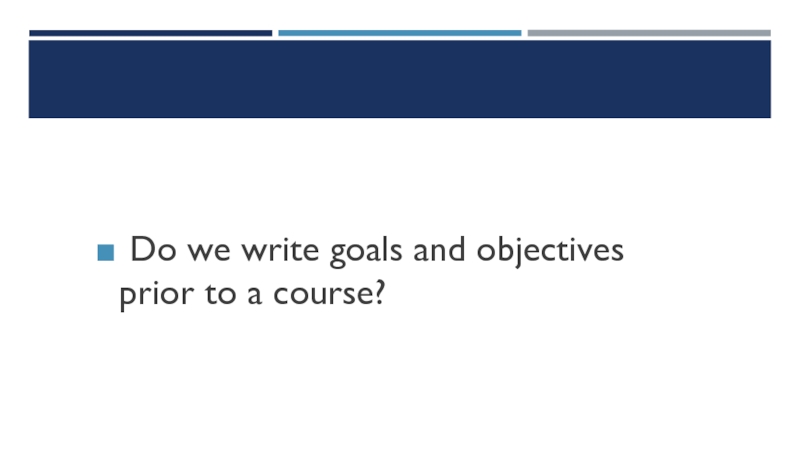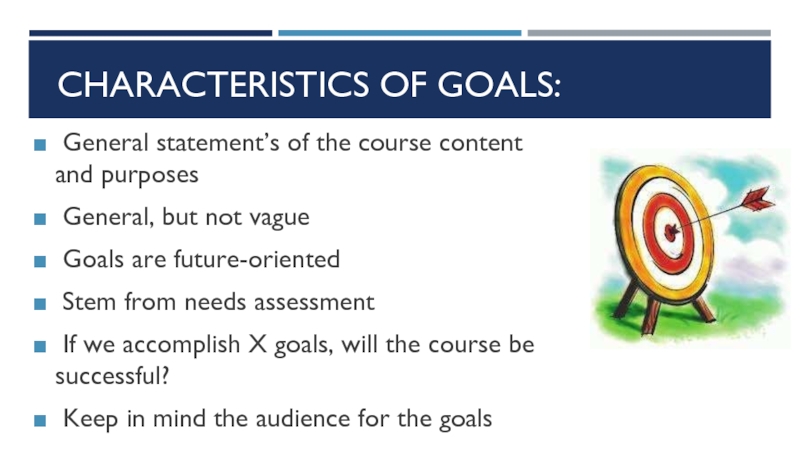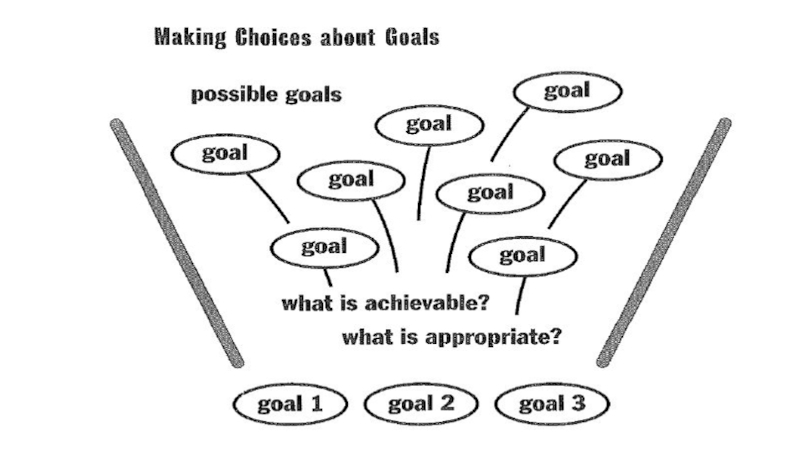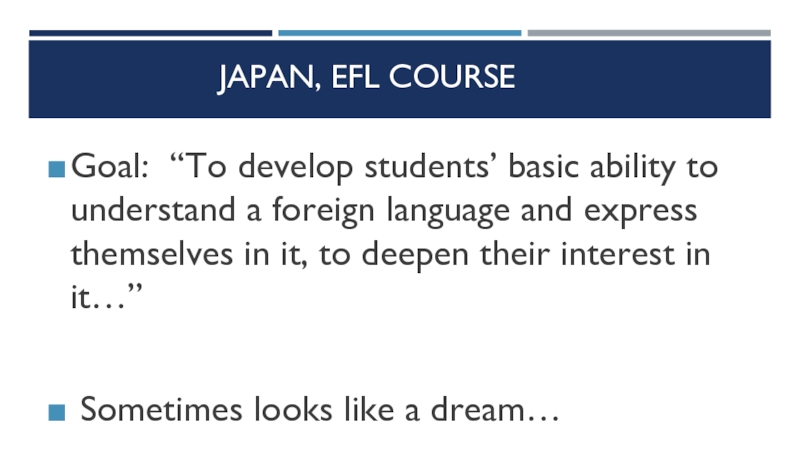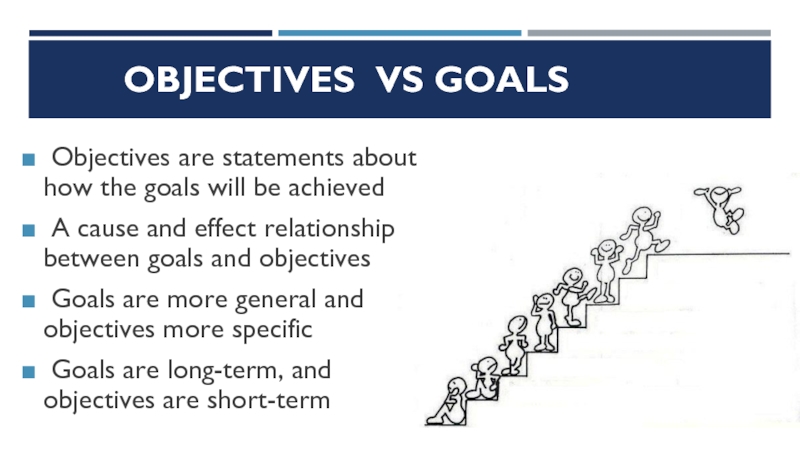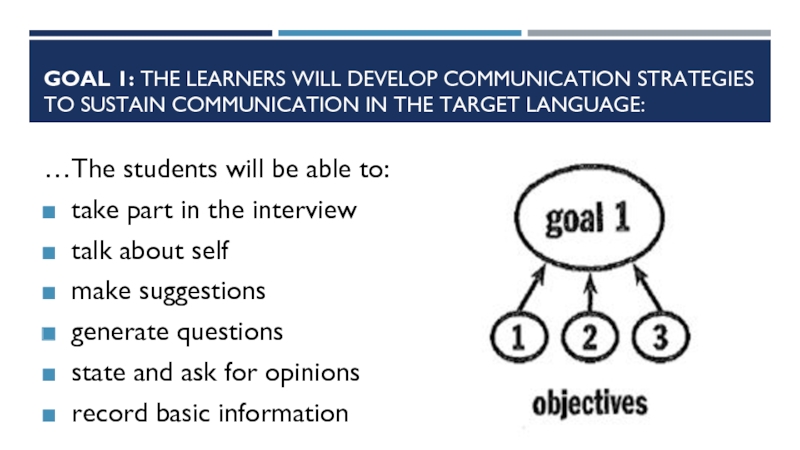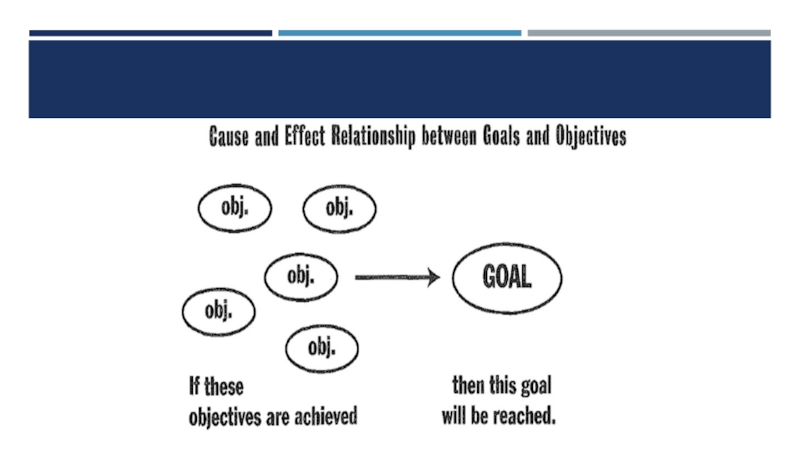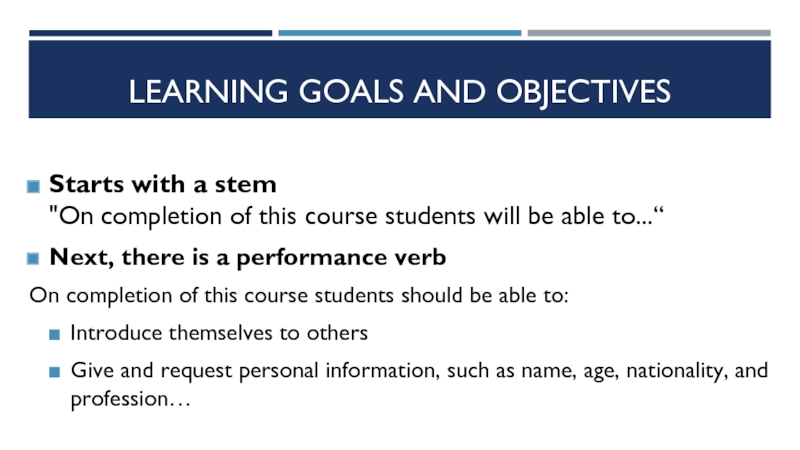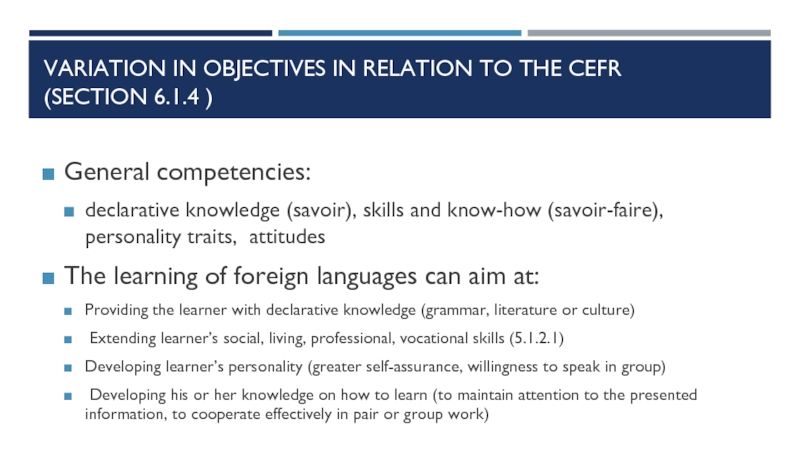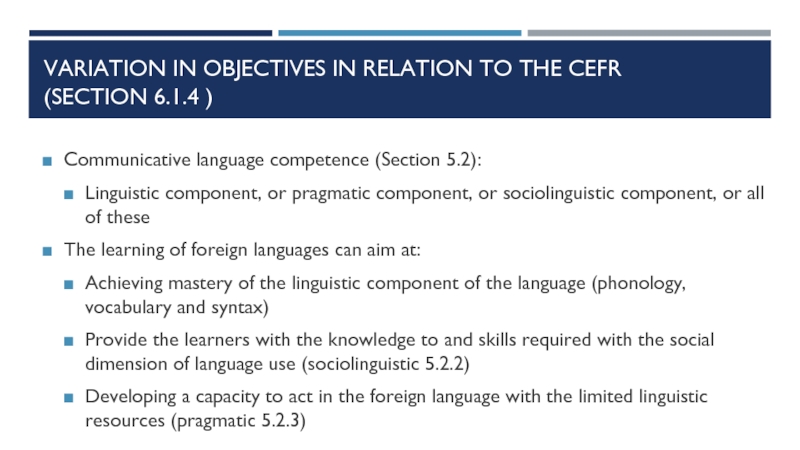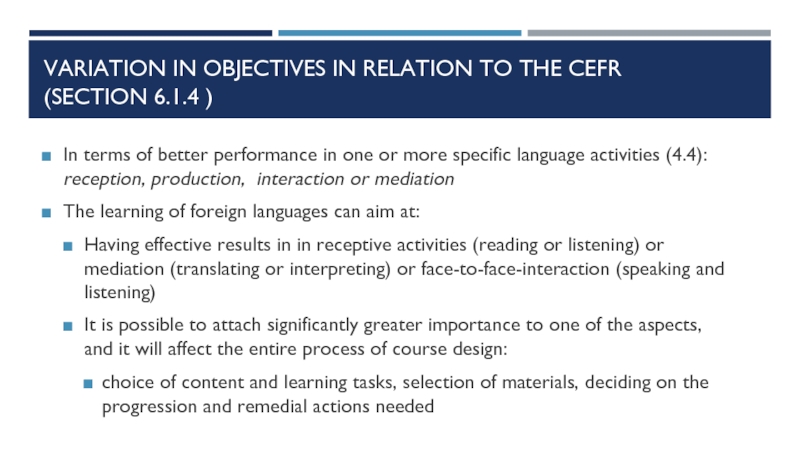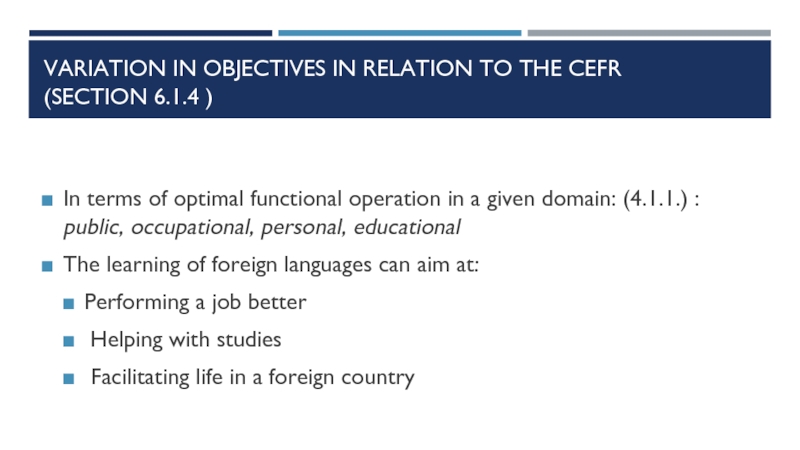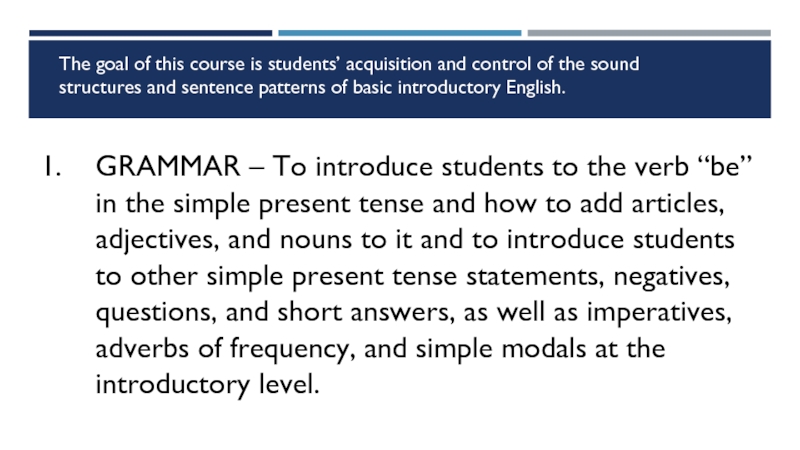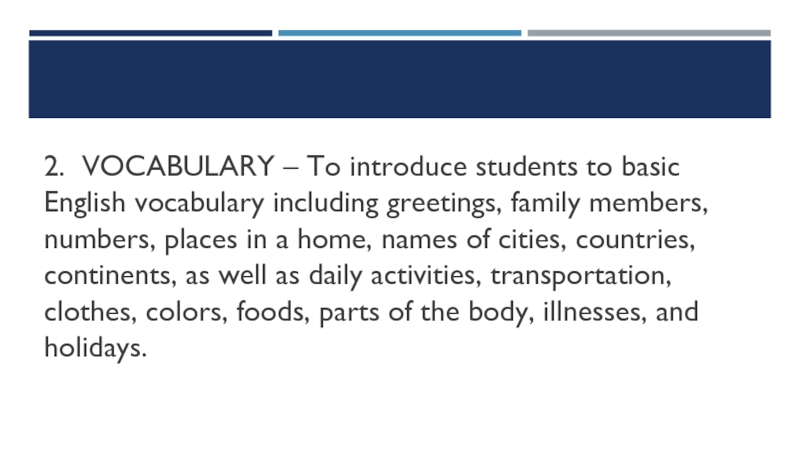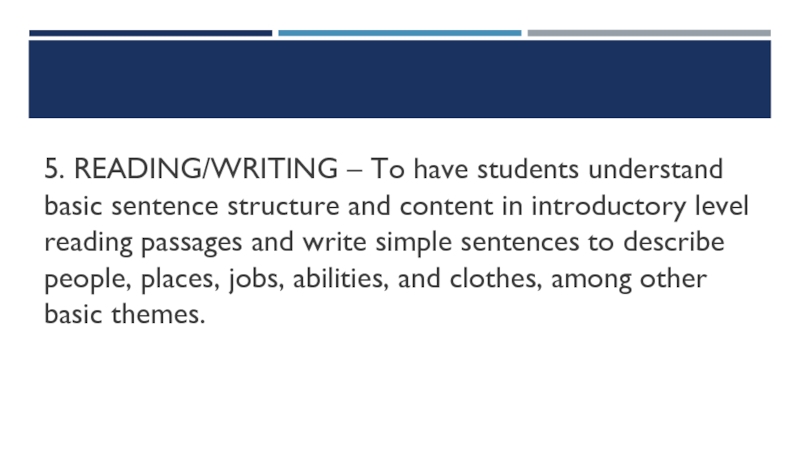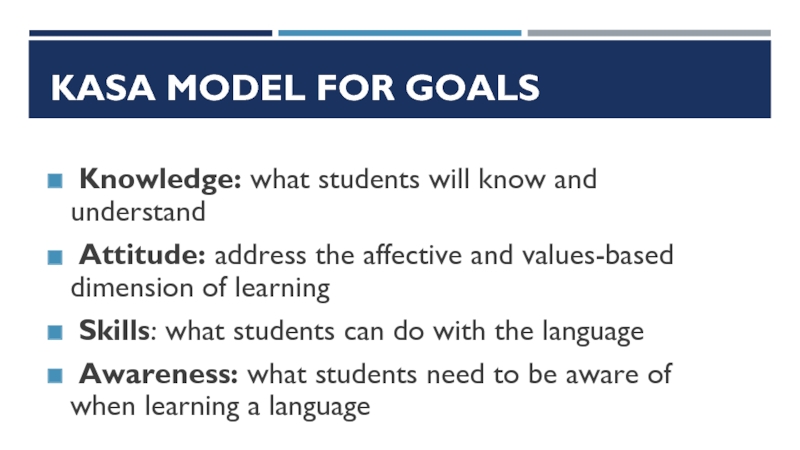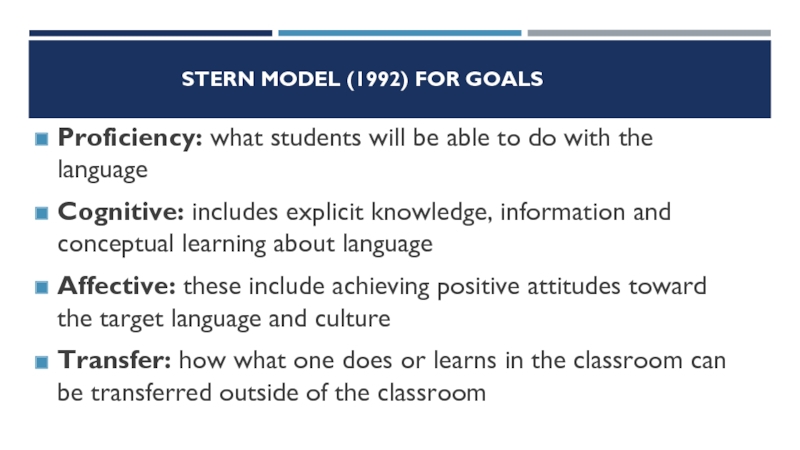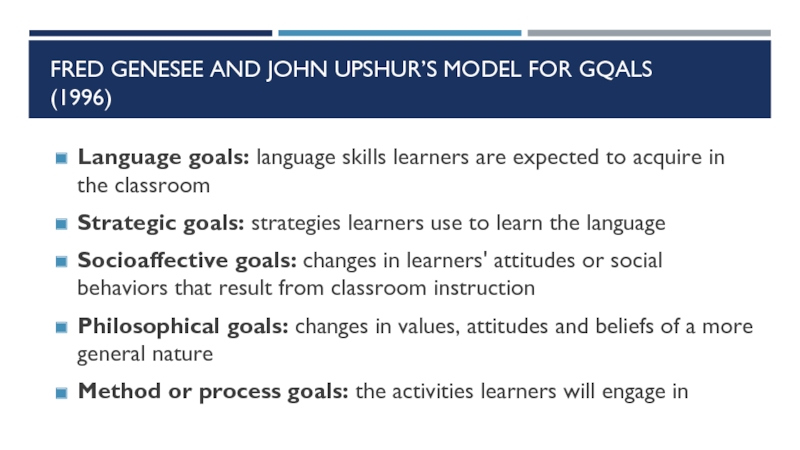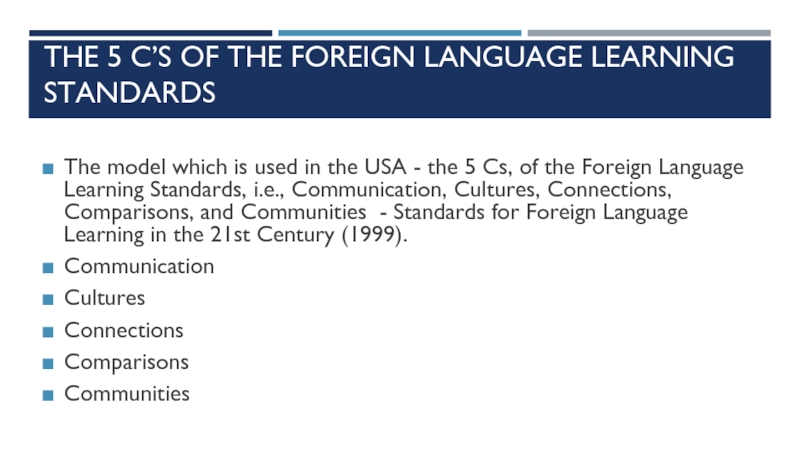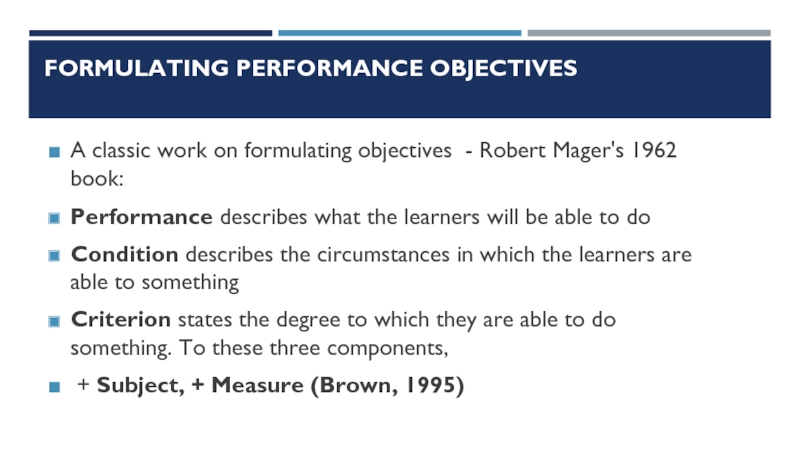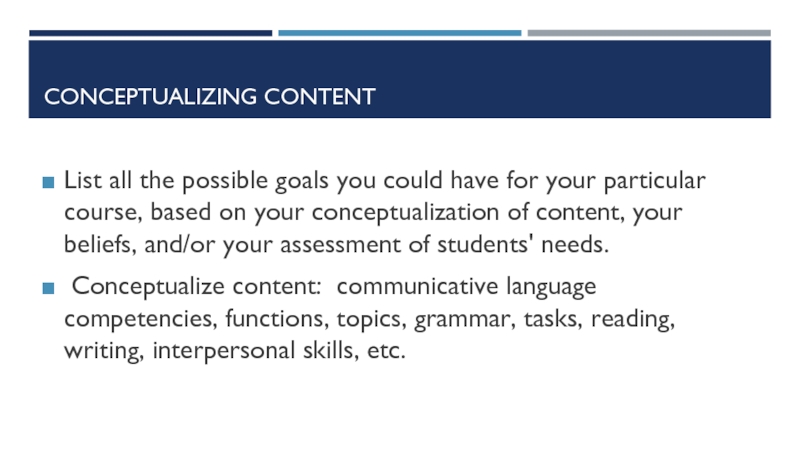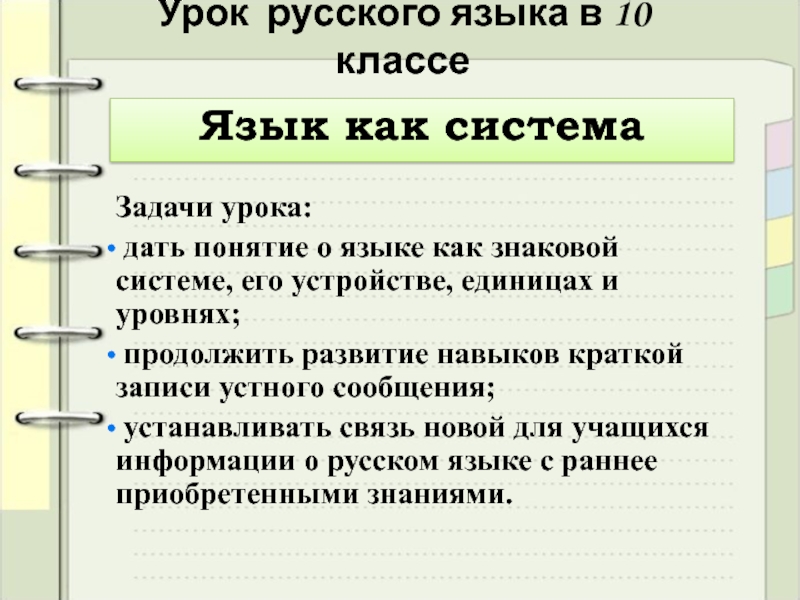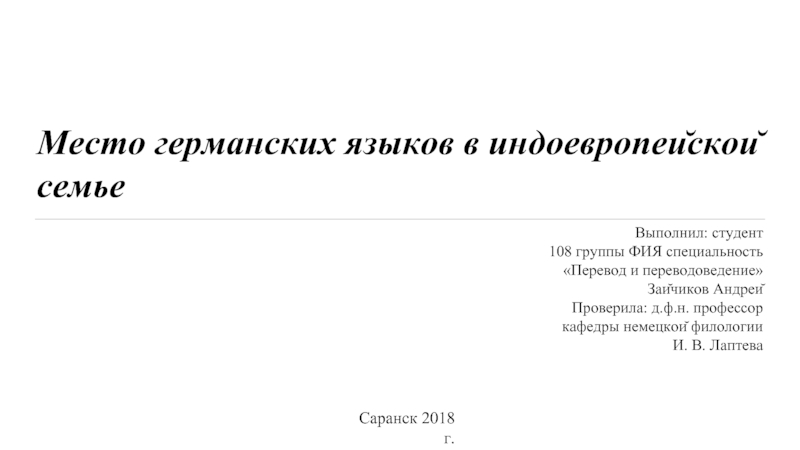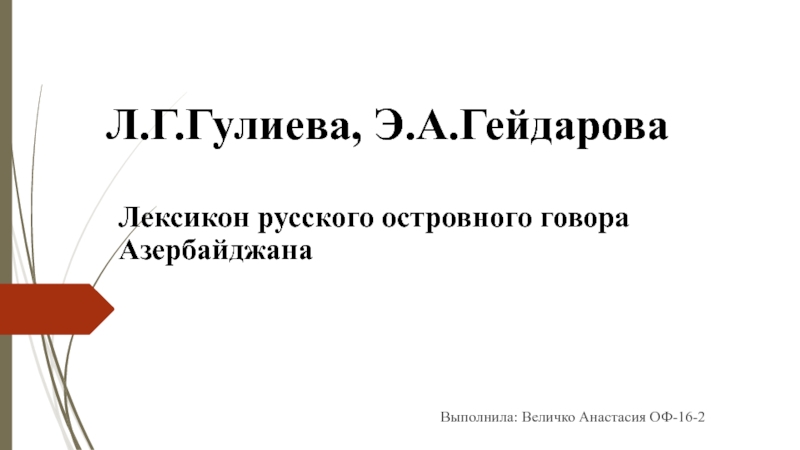- Главная
- Разное
- Дизайн
- Бизнес и предпринимательство
- Аналитика
- Образование
- Развлечения
- Красота и здоровье
- Финансы
- Государство
- Путешествия
- Спорт
- Недвижимость
- Армия
- Графика
- Культурология
- Еда и кулинария
- Лингвистика
- Английский язык
- Астрономия
- Алгебра
- Биология
- География
- Детские презентации
- Информатика
- История
- Литература
- Маркетинг
- Математика
- Медицина
- Менеджмент
- Музыка
- МХК
- Немецкий язык
- ОБЖ
- Обществознание
- Окружающий мир
- Педагогика
- Русский язык
- Технология
- Физика
- Философия
- Химия
- Шаблоны, картинки для презентаций
- Экология
- Экономика
- Юриспруденция
Definitions and characteristics of goals презентация
Содержание
- 1. Definitions and characteristics of goals
- 2. LECTURE OUTLINE Definitions and characteristics of
- 3. GOAL DEFINITION Broad statements that provide
- 4. Do we write goals and objectives prior to a course?
- 5. CHARACTERISTICS OF GOALS: General statement’s of
- 7. JAPAN, EFL COURSE Goal: “To develop students’
- 8. OBJECTIVES VS GOALS Objectives are statements
- 9. GOAL 1: THE LEARNERS WILL DEVELOP COMMUNICATION
- 11. LEARNING GOALS AND OBJECTIVES Starts with a
- 12. WHY FORMULATE GOALS AND OBJECTIVES? Formulating
- 13. VARIATION IN OBJECTIVES IN RELATION TO THE
- 14. VARIATION IN OBJECTIVES IN RELATION TO THE
- 15. VARIATION IN OBJECTIVES IN RELATION TO THE
- 16. VARIATION IN OBJECTIVES IN RELATION TO THE
- 17. GRAMMAR – To introduce students to the
- 18. 2. VOCABULARY – To introduce students
- 19. 3. LISTENING – To develop students’
- 20. 5. READING/WRITING – To have students
- 21. KASA MODEL FOR GOALS Knowledge: what
- 22. STERN MODEL (1992) FOR GOALS Proficiency:
- 23. FRED GENESEE AND JOHN UPSHUR’S MODEL FOR
- 24. THE 5 C’S OF THE FOREIGN LANGUAGE
- 25. FORMULATING PERFORMANCE OBJECTIVES A classic work
- 26. PERFORMANCE OBJECTIVES EXAMPLE Students at the
- 27. SAPHIER AND GOWER'S CUMULATIVE FRAMEWORK (1987)
- 28. CONCEPTUALIZING CONTENT List all the possible goals
Слайд 1LECTURE 3:
GOALS AND OBJECTIVES
ANNA N. KONDAKOVA,
HIGHER SCHOOL OF THE
SOCIAL STUDIES AND INTERNATIONAL COMMUNICATION, NARFU
Слайд 2LECTURE OUTLINE
Definitions and characteristics of goals
Characteristics of objectives
Goals
Variety of CEFR objectives
Frameworks for writing goals and objectives
Слайд 3GOAL DEFINITION
Broad statements that provide signposts for course development (Nunan
General statements concerning desirable and attainable course purposes and aims based on perceived language and situation needs (Brown, 1995)
Слайд 5CHARACTERISTICS OF GOALS:
General statement’s of the course content and purposes
Goals are future-oriented
Stem from needs assessment
If we accomplish X goals, will the course be successful?
Keep in mind the audience for the goals
Слайд 7JAPAN, EFL COURSE
Goal: “To develop students’ basic ability to understand a
Sometimes looks like a dream…
Слайд 8OBJECTIVES VS GOALS
Objectives are statements about how the goals will
A cause and effect relationship between goals and objectives
Goals are more general and objectives more specific
Goals are long-term, and objectives are short-term
Слайд 9GOAL 1: THE LEARNERS WILL DEVELOP COMMUNICATION STRATEGIES TO SUSTAIN COMMUNICATION
…The students will be able to:
take part in the interview
talk about self
make suggestions
generate questions
state and ask for opinions
record basic information
Слайд 11LEARNING GOALS AND OBJECTIVES
Starts with a stem
"On completion of this course
Next, there is a performance verb
On completion of this course students should be able to:
Introduce themselves to others
Give and request personal information, such as name, age, nationality, and profession…
Слайд 12WHY FORMULATE GOALS AND OBJECTIVES?
Formulating goals and objectives helps to build
Objectives serve as a bridge between needs and goals.
Stating goals and objectives is a way of holding yourself accountable throughout the course.
A clear set of goals and objectives can provide the basis for your assessment plan.
Слайд 13VARIATION IN OBJECTIVES IN RELATION TO THE CEFR
(SECTION 6.1.4 )
General competencies:
declarative
The learning of foreign languages can aim at:
Providing the learner with declarative knowledge (grammar, literature or culture)
Extending learner’s social, living, professional, vocational skills (5.1.2.1)
Developing learner’s personality (greater self-assurance, willingness to speak in group)
Developing his or her knowledge on how to learn (to maintain attention to the presented information, to cooperate effectively in pair or group work)
Слайд 14VARIATION IN OBJECTIVES IN RELATION TO THE CEFR
(SECTION 6.1.4 )
Communicative language
Linguistic component, or pragmatic component, or sociolinguistic component, or all of these
The learning of foreign languages can aim at:
Achieving mastery of the linguistic component of the language (phonology, vocabulary and syntax)
Provide the learners with the knowledge to and skills required with the social dimension of language use (sociolinguistic 5.2.2)
Developing a capacity to act in the foreign language with the limited linguistic resources (pragmatic 5.2.3)
Слайд 15VARIATION IN OBJECTIVES IN RELATION TO THE CEFR
(SECTION 6.1.4 )
In terms
The learning of foreign languages can aim at:
Having effective results in in receptive activities (reading or listening) or mediation (translating or interpreting) or face-to-face-interaction (speaking and listening)
It is possible to attach significantly greater importance to one of the aspects, and it will affect the entire process of course design:
choice of content and learning tasks, selection of materials, deciding on the progression and remedial actions needed
Слайд 16VARIATION IN OBJECTIVES IN RELATION TO THE CEFR
(SECTION 6.1.4 )
In terms
The learning of foreign languages can aim at:
Performing a job better
Helping with studies
Facilitating life in a foreign country
Слайд 17GRAMMAR – To introduce students to the verb “be” in the
The goal of this course is students’ acquisition and control of the sound structures and sentence patterns of basic introductory English.
Слайд 18
2. VOCABULARY – To introduce students to basic English vocabulary including
Слайд 19
3. LISTENING – To develop students’ understanding of basic spoken English
4. SPEAKING/PRONUNCIATION – To get students to focus on specific sounds such as /r/, /sh/, /ch/ and final /-s/ as well as intonation of basic vocabulary or word stress and to ask yes/no questions politely and provide logical responses.
Слайд 20
5. READING/WRITING – To have students understand basic sentence structure and
Слайд 21KASA MODEL FOR GOALS
Knowledge: what students will know and understand
Skills: what students can do with the language
Awareness: what students need to be aware of when learning a language
Слайд 22STERN MODEL (1992) FOR GOALS
Proficiency: what students will be able to
Cognitive: includes explicit knowledge, information and conceptual learning about language
Affective: these include achieving positive attitudes toward the target language and culture
Transfer: how what one does or learns in the classroom can be transferred outside of the classroom
Слайд 23FRED GENESEE AND JOHN UPSHUR’S MODEL FOR GQALS
(1996)
Language goals: language
Strategic goals: strategies learners use to learn the language
Socioaffective goals: changes in learners' attitudes or social behaviors that result from classroom instruction
Philosophical goals: changes in values, attitudes and beliefs of a more general nature
Method or process goals: the activities learners will engage in
Слайд 24THE 5 C’S OF THE FOREIGN LANGUAGE LEARNING STANDARDS
The model which
Communication
Cultures
Connections
Comparisons
Communities
Слайд 25FORMULATING PERFORMANCE OBJECTIVES
A classic work on formulating objectives - Robert Mager's
Performance describes what the learners will be able to do
Condition describes the circumstances in which the learners are able to something
Criterion states the degree to which they are able to do something. To these three components,
+ Subject, + Measure (Brown, 1995)
Слайд 26PERFORMANCE OBJECTIVES EXAMPLE
Students at the Guangzhou English Language Center will
Слайд 27SAPHIER AND GOWER'S CUMULATIVE FRAMEWORK (1987)
Coverage objectives: material to be
Activity objectives: what the students will do with the material
Involvement objectives: how the students will become engaged in working with the material
Mastery objectives: what the students will be able to do as a result of a given class or activity
Generic thinking objectives: describe the meta-cognitive problem-solving skills
Слайд 28CONCEPTUALIZING CONTENT
List all the possible goals you could have for your
Conceptualize content: communicative language competencies, functions, topics, grammar, tasks, reading, writing, interpersonal skills, etc.
